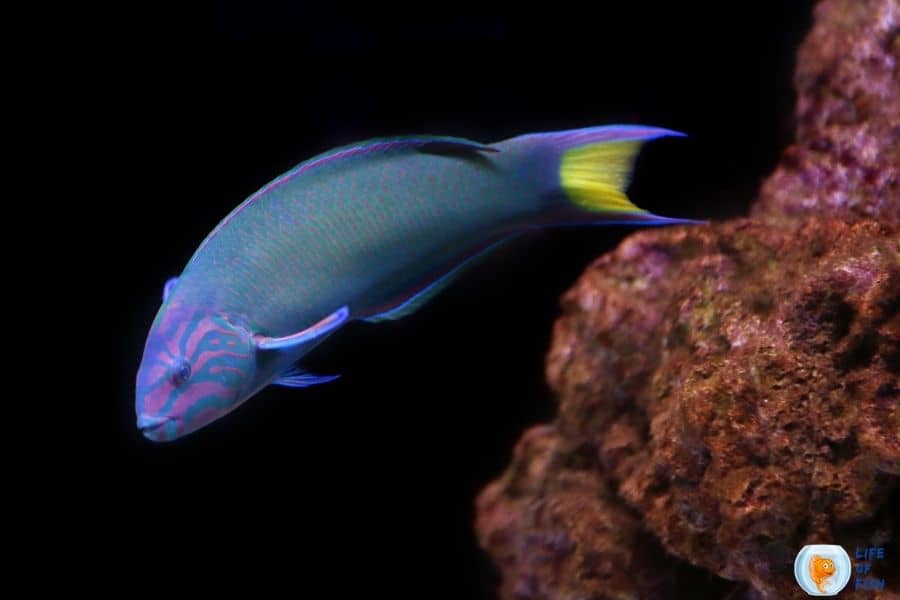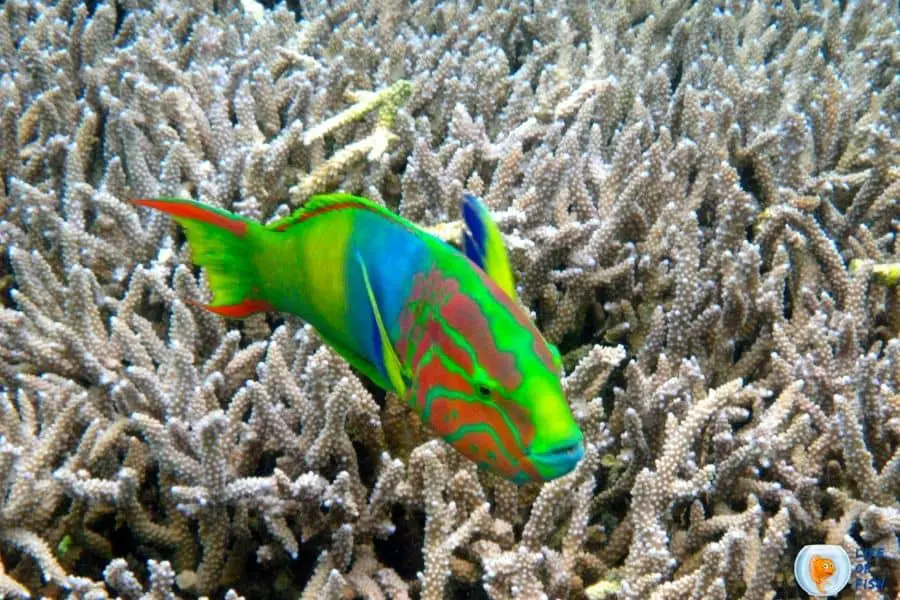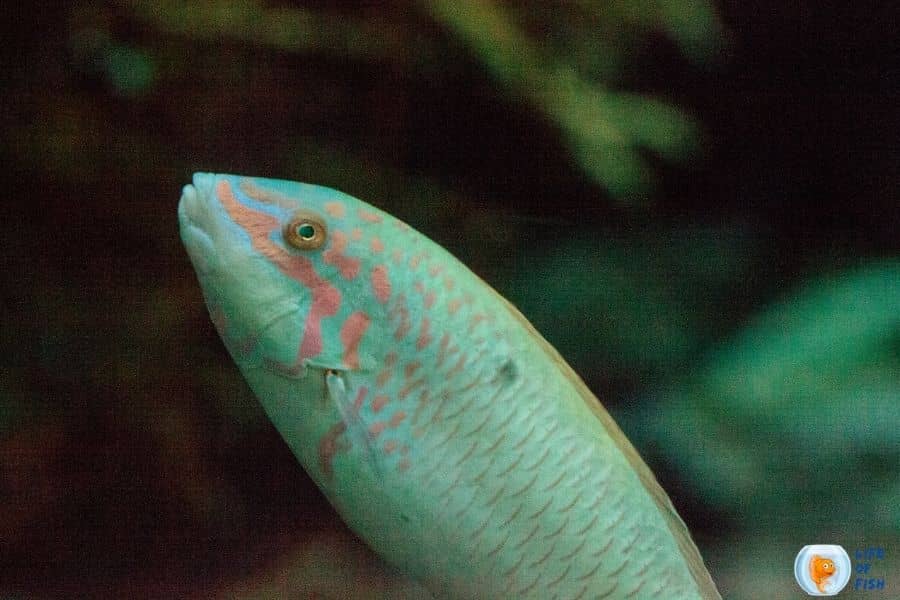If you are looking for a magnificent looking fish that is active and engaging, Moon wrasse might be the one you are looking for. They are beautiful, active, and friendly with humans like koi and goldfish.

Unlike most other saltwater fish requiring expert-level knowledge, they are surprisingly beginner-friendly. They are hardy, easy to feed, and generally peaceful under certain tankmates. So, if you are a beginner aquarist that knows a little bit about keeping saltwater conditions in aquariums, give them a chance, and you’ll love these fish.
This is a comprehensive care guide for moon wrasse. If you are interested in getting one (or more) of these fish for your tank, this guide might help you make an informed decision before doing so. But first, let’s take a look at what they are all about.
One Look Care Guide
Jump To
| Scientific name | Thalassoma lunare |
| Common name | Moon wrasse Lunar Wrasse Lunare Wrasse Crescent Wrasse Lyretail Wrasse |
| Care level | Moderate |
| Native to | Indian and Pacific Oceans |
| Type | Saltwater fish |
| Color | green to blue body with soft purple marks on the scales and yellowtail |
| Tank size | 75 gallons for one fish |
| Preferred temperature | 74° – 79° F (23 – 26° C) |
| Other water parameters (ammonia, etc.) | pH: 8.1-8.4 Hardness: dKH 8-12 Specific gravity: sg 1.020-1.025 |
| Preferred salinity | sg 1.020-1.025 |
| Size | 10 inches (25cm) |
| Life Span | Up to 10 years in captivity |
| Temperament | Semi-aggressive |
| Recommended tank mates | Large predatory fish |
| Preferred food | Carnivore, live food |
| Feeding frequency | Two times per day |
| breeding | Not bred in captivity |
What is Thalassoma lunare?
They also known as Lunare Wrasse, and they are saltwater fish that belongs to the family Labridae.
Scientifically named Thalassoma lunare, and has many common names. All are related to its yellow color lunar-shaped caudal fin. Some common names are,
- Lunar Wrasse
- Lunare Wrasse
- Crescent Wrasse
- Lyretail Wrasse
They are initially found in the Indian and Pacific Oceans.
They are prevalent in the aquarium trade because of its good looks. They have unique color pattern that many people fall in love with. Adult fish have a green to the blue body with soft purple marks on the scales. They have irregular pink to violet stripes on the head and an elongated red spot on the pectoral fin.
The caudal fin (tail) of an adult fish has a yellow color, and it is shaped like a crescent or a new moon.
Juvenile fish has more of a circular tail with bright blue coloration on its scales. They also have irregular pink to violet stripes on the head and no elongated red spot on their pectoral fins. Juvenile fish also has a dark spot on the caudal and mid-dorsal fins. These dark spots are lost when they are about to mature.
Take your fish knowledge to the next level with our comprehensive guide to wrasse fish!” – wrasse fish
Their habitats
They are endemic to many tropical reefs throughout the Indian and Pacific oceans. They can be also found in the Red sea, from East Africa to the Line Islands, Nothern and southern Japan, Lord Howe Island, New Zealand, and Rapa.
Apart from that they have also been recorded from South Australia, Queensland north to the Great Barrier Reef and Palau in Micronesia.
Especially they are found in the depth range of 2 to 30 meters during the day. At night they can go as deep as 60 meters. They prefer oxygen-rich water and reef habitats with sand or rubble. This fish is also found in the lagoon, seaward reefs, and offshore areas.

How big do they get?
They a mid-sized fish that grows up to 10 inches (25cm). However, they have stunted growth in captivity. Most lunar wrasses kept in aquariums grow only about 6 to 7 inches.
Are they aggressive?
They are an aggressive fish species. But, they only show aggressive behavior to their prey. They are generally peaceful with larger, aggressive fish. Besides their aggressiveness toward food, they are considered among the most peaceful species in the Thalassoma genus.
Their behavior
They are very active fish species that love to explore their surroundings.
They are generally peaceful but can be pretty territorial during new tank setups, and there might be ugly fights involved. They are always looking for hiding places, and they often curl up under the reef rocks. They are also constantly exploring their territory in search of food.
They will often dart out of its hiding place to suck on coral reefs or ambush any prey passing by.
These fish are predatory fish that prey on any fish, invertebrates, or other creature if they are small enough to fit in their mouths.
So, small fish species will have difficulty getting away from these fish. They will often swallow their prey whole. Interestingly, these fish are social, hence interacting with humans. They are known to play fetch, follow humans around and even dance when their owners are around.
They are a very interactive fish species that will perform any trick for a snack. Because of this intelligent behavior, many owners fall in love with their pets.
How long do They live?
The actual life span of this fish in the wild is still unknown. However, they are known to live around ten years in captivity.
Moon wrasse care
Unlike many other saltwater fish species, these fish are relatively easy to care for in captivity. All they need is a saltwater aquarium that is large enough for them to grow to their full size. They also need rocks and live corals for them to hide in. They are generally very peaceful with tankmates that are not smaller than their own size.

- Size
They are medium-sized fish that reaches a maximum length of about 10 inches (25cm). However, they have stunted growth in captivity.
- How many fish should be kept together?
You can keep these fish in solitary or as a pair if you like. However, they will need adequate space to swim around, so a 125 gallon or larger tank is required for two fish.
Moon wrasse tank size
They require a large aquarium due to their size and active behavior. They need a minimum of 75-gallon tank if kept alone.
Tank setup
Substrate
They tend to bury themselves when frightened and sleeping, so a sandy substrate is preferred as their natural habitats also contain sand in the bottom.
Decorations
They require plenty of hiding places to hide when frightened, which they will most certainly be. The fish will need live rocks and/or live corals to provide them with hiding places.
Lighting
They are not demanding in terms of lighting, but they do need to have some light. However, given their large body size, you will need to ensure that the lighting is adequate for them to survive. Standard fluorescent lighting can provide you with that.
Filtration and other equipment
Filtration is vital in any aquarium, but it is indispensable with them. A powerful filtration will ensure that the water quality is good for the fish to live in.These fish require high-oxygenated water, so a protein skimmer and a powerhead that bubbles water into the aquarium are good choices.
Tank Lid
Since these are very active fish, a tank lid is essential to prevent your fish from jumping out of the tank.
Water quality condition
The preferred water hardness level is dKH 8-12, while the specific gravity should be around sg 1.020-1.025.
These fish require water changes of about 10% per two weeks or 20% per month.
Thalassoma lunare breeding
They are not yet bred in captivity. In the wild, these fish practice group spawning in order to reproduce. They fertilize their eggs externally and leave them to hatch.
- Male or female identification
Males usually have more vivid coloration than females, while this difference is prominent in the alpha male. They are protogynous hermaphrodites. They start their life as females and change their sex when needed.
As per reports, this process will take only about ten days, and the most dominant female will be the alpha male.
When it’s time to spawn, the alpha male will change its color to completely blue and gather all the females in its “harem” to spawn.
Special tips
They are very active fish and move around the tank all day long. So, they require plenty of free space in the tank to move around. It is also an intelligent fish, so they can learn to respond to their owner’s call and even recognize their owner. Therefore, you can try training your fish with methods you try with goldfish.

How to feed Thalassoma lunare?
They are generalist predators, so they eat anything small enough to fit in their mouths.
They will also eat invertebrates and small fish, so be sure to provide them with their dietary requirement of crustaceans.
They can be fed about twice a day with different food types.
They have a hearty appetite, so they are not picky at all. They will usually accept any food you offer once they are acclimated to the tank, which won’t take too long. However, their food should be about the same size as their mouths to prevent choking.
Moon wrasse tank mates?
They are generally peaceful fish that can live with any fish if they are similar-sized or larger than a wrasse.
If you want to keep a group of these fish, make sure that they are not in a high-traffic zone of your tank as they can easily be bothered by other species.
Compatibility map
In general, they are good community fish as long as they are not the only dominant fish in the tank. However, if you want to keep them with other wrasses, make sure that your tank has at least 30 gallons of water per fish and select wrasses that are similar in size.
Since these fish can defend themselves when threatened, they can also fit in with aggressive tank mates. They are territorial and will nip, chase or harass any other fish that trespass their territory. So, when choosing suitable tank mates for them, ensure that they can defend themselves.
They are not aggressive towards fish of the same size so you can keep them with fish of similar sizes. They also get along with their own species very well. So, if you want to keep a group of these fish, make sure that there are more females and only one male.
Any fish, crustacean, mollusk, or smaller creature smaller than them would not be compatible in a moon wrasse tank.

Related questions
- How much is a moon wrasse?
They are generally inexpensive fish. On average, they are about $20-$30 per fish. However, their price can vary depending on where you buy them and whether or not they are juveniles or adults.
- Are lunar wrasse Hardy?
They are extremely hardy fish that can survive in a wide variety of water conditions. This makes them a perfect choice for both beginner and experienced aquarists.
Conclusion
If you are looking for a beginner-friendly saltwater fish that is beautiful, active, and engaging, give them a try. These fish are hardy, easy to feed appetites, and generally peaceful under certain tankmates.
They also require little knowledge about keeping saltwater conditions in an aquarium, making them perfect if you want something hassle-free yet still very beautiful!
Read Next : Coris Wrasse | 12 Incredible Coris Wrasses Bird Wrasse | Learn About Hardy And Bird-Like Marine Fish |
